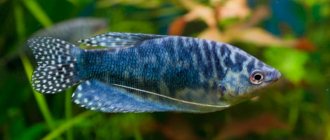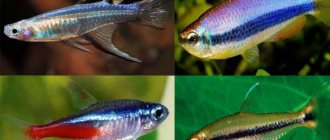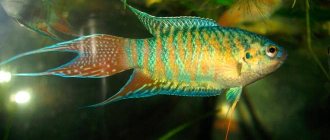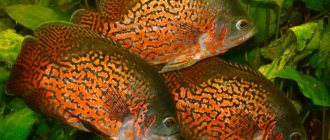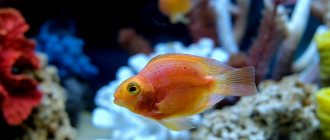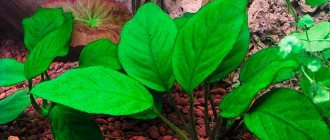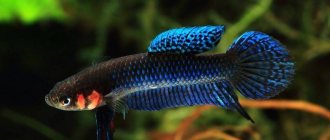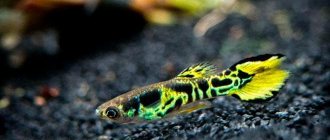Cichlazomas are quite popular inhabitants of the home aquarium, due to their beauty and unpretentiousness. This family is distinguished by a huge classification, consisting of various varieties, although recent works by scientists indicate that this genus no longer exists - all its representatives are classified into other classes.
Nevertheless, established traditions make it possible to talk about the maintenance of these unique and beautiful predators within the framework of general material, because their care is almost the same.
Description and natural habitat
The aquarium fish Cichlazoma comes from the warm waters of America, Asia and Africa. Scientists introduced it to lovers of home ponds at the end of the century before last.
Cichlazomas belong to the class Cichlids and are predators or omnivores. They have a powerful and fairly large body (up to 20-40 cm in length), high in the dorsal fin and somewhat flattened laterally.
These are typical bottom dwellers; they also love thickets of aquatic plants and partial shade. They choose bodies of water with a slow flow, usually with a silted bottom.
The high vitality and unpretentiousness of these underwater inhabitants makes their reproduction possible not only in the natural environment, but also in cichlids.
The fins of fish end in sharp tips (they are ray-finned), but can vary in shape depending on the variety. Males are usually significantly larger than females in size and brightness of color. As a rule, monogamous, an established couple can delight their household members with their beauty and excellent behavior for many years (up to 15 years).
Photo gallery of cichlaz:
The eyes of cichlases are very expressive, large, and black. A large mouth, voluminous gills, dense leathery cover and powerful scales, a muscular strong body with a strong spine are all distinctive features of this family.
The scales adhere so tightly to the skin that parasites can almost never get under them. This is another explanation for the resilience of fish. The integument is restored so well that wounds and abrasions received during hunting or mating games heal very quickly. The color of scales and fins can be varied (depending on the species), but turquoise and steel tones, dark stripes and spots predominate more often.
Its origin and description
Cichlazoma flamingo is a species of aquarium fish whose origin aquarists still cannot accurately determine. There are many different versions. In one of them, experts claim that this species is an albino black-striped cichlazoma. But this version does not have clear confirmation, since albinos do not have color pigment, as a result of which the fish should be white, but it has black eyes and a pink body.
Another version implies that this type of cichlazoma occurred as a result of a natural or gene mutation. In any case, this type of fish is very attractive. The word “flamingo” in the name indicates that the fish has a color ranging from pale pink to deep pink. As a rule, a more saturated shade is found in females. The sizes of the fish vary from 8 to 15 cm, with males being the larger individuals.
In terms of the shape of the body and fins, cichlazoma does not have any special differences from other species of fish. The disadvantages of breeding such fish include the fact that it is better to use a large aquarium, since they cannot easily tolerate high water temperatures and lack of oxygen. This species is predatory, so problems may arise when breeding cichlases together with other fish species. Firstly, they have a hard time getting along with other fish, and secondly, other fish may be left without fins or even simply eaten. Despite this, Flamingo cichlid remains a fairly popular exotic species of aquarium fish.
Mr. Tail recommends: species of cichlases
So far, the existing gradation in the aquarium industry makes it possible to classify cichlases into one family. There are many scientific classifications, but it is more interesting to simply describe the varieties that are most popular among lovers of home artificial reservoirs.
Black-striped cichlazoomas
Very popular in modern aquarium hobby. These are small perch-like fish with bright colors and a rather calm character. They are capable of aggression during the period of spawning and caring for offspring, so it is still better to keep them in a cichlid with other representatives of their family. These can be parrots, pseudotropheus, barbs, gourami, swordtails, thornets.
The name Cichlasoma nigrofasciatum includes two words, nigro - white and fascia - black, this fish is often called zebra.
It is considered a small fish, in nature its size is about 15 cm, in an artificial reservoir it is somewhat smaller.
The main color background is grayish-bluish, with wide, alternating white and black stripes on it, which really makes the fish look like a zebra.
Males are much larger than females, they are distinguished by the pointed shape of their anal and dorsal fins, and during the spawning period a bright red stripe is visible on their belly.
Diamond cichlazomas
These cichlids really resemble a diamond due to the iridescent large scales and silvery spots evenly scattered throughout the body, even on the fins.
Body length reaches 15-17 cm, males are larger.
This cichlid is also very popular, in second place after the black stripe. Cichlasoma cyanoguttatum is also called pearl cichlasoma and Texas cichlasoma.
These fish are also quite peaceful for predators, although they are prone to fighting for territory.
Cichlazoma Severum
A very bright cichlasoma with a yellowish body, on which small orange specks are scattered, although in nature the color is completely different - grayish-greenish. But in aquariums only selected varieties are found, but they are also rare.
Sometimes it is called false discus because of its color. Whether these fish belong to the genus Cichlasom or Heros has not yet been fully determined.
In addition to the above-described “red pearl severum”, the decorative forms “blue emerald”, “red-headed”, “golden”, and many others are also in demand.
This variety of cichlases is highly aggressive, especially intraspecific. It is better to keep them separately in several pairs in a very large tank with proper zoning.
Cichlazoma Meeka
Another fairly popular species of aquarium cichlases comes from Guatemala and Southern Mexico.
The body length of the fish, painted silver on top, is 14-15 cm. Larger males have bright red spots on the belly and the lower part of the large head. The sharp fins are colored gold or have a purple tint.
Typically, these underwater inhabitants behave calmly in the aquarium, but defend their territory, so the tank should be divided into spacious zones.
Cichlasoma meeki in the wild is much larger in size, up to 35-40 cm. The fish is named after the American ichthyologist Meeki, who discovered this species of perciformes in 1933. Sometimes it is called mask because of the peculiar color of its head.
In the aquarium, Meeks usually behave slowly, but they completely transform during the mating season. At this time, it is better to house the couple separately. They love to rummage in the sandy bottom, picking out algae and turning over parts of the decorations.
Lionhead cichlazomas
They differ from other species of cichlids by a large knob-like growth above the upper part of the huge head.
Steatocranus casuarius's style of movement in a reservoir is strikingly different from the leisurely Meeks; it seems that the fish is jumping and galloping along the bottom, where it spends most of its time.
A monogamous couple usually inhabits its own cave, where it breeds offspring. It is not recommended to keep more than three families in one, even a large aquarium.
The color of the scales is usually dark with a bluish, purple or almost black tint, but gray-silver individuals are also found.
Cichlazoma Flamingo
These predatory fish are slightly smaller than their family members - from 8 to 14 cm in length. The name was given because of the unusual pinkish color, which can be very pale or more saturated. The most peaceful of all known species of cichlases.
Ichthyologists have still not agreed on the origin of this species. Some consider it to be an albino form of the black-striped cichlid, but this can hardly be true (the eyes are not red, there is pigment in the color). Others believe that the rare shade of scales is the result of a natural mutation.
Rainbow cichlazomas
One of the largest species of cichlids, even in an artificial reservoir some individuals reach 20 cm in length.
The coloring of the scales contains many bright colors - yellow, green, red, blue, which gave rise to the name of the variety.
The fish is very aggressive. Usually, one pair is selected from 6-8 individuals and moved into a separate tank. Even when zoning an aquarium, fights between males are inevitable.
Cichlazomas Bees
These perch-like fish are small in size (8-10 cm) and in nature are more often found in the Amazon River basin.
They have a very unusual and remarkable color. Each scale has a blue spot, which, when refracted in light rays, gives a unique play of colors - gold, black, azure.
Other names for the species are eight-banded, cichlazoma Biocelatum.
The brightest color is found in yearlings. Juveniles are paler and calmer. And adult males do not get along with almost anyone; it is better for the pair to be kept in a separate aquarium.
Cichlazomas Labiatum
They are distinguished by their uniform yellowish-pink color and high intelligence. If a person approaches the tank, they follow him with their gaze and even beg for food. At the same time, their neighbors in an artificial reservoir are usually completely ignored.
The large head ends in a large, well-defined mouth, which is why Labiatum is often called the big-lipped cichlazoma.
Nicaraguan cichlizomas
Large underwater inhabitants (20-25 cm in length) with a large convex head and low lips.
The color is usually a mixture of three colors - a silver body, a bluish upper part and forehead, and a purple belly.
Sedzhik's cichlazomas
A small aquarium fish (10-11 cm), peaceful, even timid in nature, there must be caves and grottoes at the bottom for shelter.
The light brown, flat and round tall body is equipped with yellowish fins. Dark wide stripes cross the body.
This species has a pronounced habit of defending its territory, especially during the mating season. It is better to keep the pair in a small (about 50-100 l) own tank.
Smaragd cichlazomas
They are very different in their behavior from other cichlids. They can be called benign neighbors rather than dangerous territorial predators.
If the wine cichlid gets scared of something, it freezes and falls to the bottom, resembling a fallen leaf. This is facilitated by the peculiar coloring of the body (yellowish, pinkish, gray tones), it helps the fish to mimic.
At the bottom of an artificial reservoir where this species of cichlids is kept, there should be shelters - grottoes, caves, dark algae. It is better to choose brown soil, then the fish Cichlasoma temporale crassa will not be stressed.
Citron or lemon cichlazomas
They are considered excellent intercalary specimens due to their bright orange light coloring and forehead-shaped head.
They usually behave calmly in the aquarium, somewhat more aggressively only during the mating season and when the tank is overpopulated. Cichlasoma citrinellum are omnivores and do not refuse live, dry and plant food. They can even eat zucchini and watermelon.
Cichlazomas Menonuata
Shy and peaceful, they can even get along with angelfish. They can jump out of a pond out of fright.
The color of the body is dull, pale yellow; a black oblique stripe runs along the body from the pectoral fin in the middle of the dorsal fin.
Cichlazoma Salvini
Cichlasoma salvini originates from the central part of the American continent. The main background of the body is greenish or brownish-yellow with bright black stripes along the entire upper half and a red belly (in males).
The fish are quite peaceful, but can defend their territory; zoning of the aquarium is necessary. Body length is from 13 to 16 cm.
Cichlazoma Spilurum
The gray cichlasoma Cichlasoma spilurum has a large body, painted in a grayish-metallic color with pale transverse stripes and retracted dorsal and ventral fins.
Quite calm, but during spawning they can become very nervous, and aggression is possible.
Cuban cichlises
Cichlasoma tetracanthum or Tetracanthum in natural conditions lives in calm waters of Cuba and Barbados.
The main background of the body is grayish-silver. Strokes and spots of black color are scattered across it. The drawing, in spite of everything, is not repeated, it is unique.
Very dangerous and aggressive, suitable only for keeping as a pair in a species aquarium. Large ones - about 20-25 cm.
Cichlazomas Fascetum
Cichlasoma facetum or Chanchita comes from reservoirs in Brazil, Honduras, Uruguay, and Argentina. The colors are varied - grayish-yellow, bluish, green, red tones. The transverse stripes are pale and extend throughout the body.
Small, but very aggressive, this is a territorial species (protecting its living space).
Managun cichlazomas
Parachromis managuensis is a very powerful and beautiful fish with an unusual black and gold color and a unique shape of fins, which is why they received their second name - Jaguar. The body length of these underwater inhabitants of aquariums is large - up to 35-40 cm.
A tank of at least 500 liters is suitable, and preferably a large one, since the fish are aggressive and always make very sharp leaps when moving.
Eliot's Cichlazomas
They are somewhat reminiscent of Meeks in color and behavior, but the red spot on the belly is brighter.
Cichlazomas Golden Leopards
This is an endemic species of African Lake Malawi. Large fish (25-30 cm) prefer bottom habitat and are able to live at depths of up to 25 m.
Because of their unique body coloring—large black spots on a lemon background—they are often called Golden Giraffes.
Unlike their brothers in the family, they are not monogamous, but prefer to live in a small harem, where there are three or four females per male. They should also be kept in a large species aquarium (at least 600 l). Two males will not get along together; one of them will definitely die in a fight.
A distinctive feature of this variety is the ability to interbreed with other species of cichlids.
Cichlazoma Golden Parrot
Auratus are distinguished by the different colors of male and female individuals (golden and azure colors) and the special aggressiveness of females.
If there is no male in the aquarium, then the female is capable of changing color and becoming a “false male”.
It is also endemic to Lake Malawi, preferring to live in a harem. For one male you need two or three females. In an artificial habitat, these aggressive and large individuals can only live separately in a species aquarium.
Cichlazomas Pseudotropheus
Lombardos are very beautiful, but only experienced aquarists can keep them. Fish are not only extremely aggressive, but also very sensitive to fluctuations in water parameters.
The color of male and female individuals is so different that they are often not recognized as individuals of the same species.
Cichlazomas Flowerhon
Otherwise, the Three-hybrid parrot is a breeding species of cichlid. It is distinguished by a fatty lump on the forehead, frequent sharp changes in bright color, phlegmatic nature and a tendency towards solitude, with a heart-shaped pattern on the sides.
Albino cichlazomas
They are rare, have white, even transparent, skin and scales, low immunity and poor survival.
Melanochromis chipokae
The Melanochromis genus includes about one and a half dozen species that live in the rocky biotopes of the African Lake Malawi. One of them, Melanochromis Chipoka M. chipokae Johnson, 1975, can be recommended to aquarists who want to start working with cichlids of African lakes.
From the editor: Mollies: photo, description, keeping in the aquarium
In aquariums, fish grow up to 14 cm. The color of males is dark blue with one longitudinal white-blue stripe in the middle of the body and many spots and streaks at the base of the anal fin. Females are bright yellow with two black horizontal stripes along the body and one stripe on the dorsal fin.
It is better to keep Chipok melanochromis in nests, when there are from two to eight females per male. The minimum volume of the aquarium is 150 l. Get along with these fish
other types of melanochromis, labeotropheus, etc. Shelters for fish can be created from stones, shell rock, plastic, and shards. If you want to plant plants, then you need to choose hard-leaved species: Vallisneria, hornwort. Lighting is better combined - incandescent and fluorescent lamps. Water hardness 8-20°; pH 7.2-8.5; temperature 25-27 °C. Aeration, filtration and changing 1/4 of the water volume once a week are required.
The food is mainly vegetable: black bread, lettuce, nettle, cabbage, etc. In case of vitamin deficiency, vitamins are added to the bread, rolled into balls, and fed to the fish in this form. It is useful to give a little sweet red pepper. Among animal foods, we can recommend daphnia and cyclops, which provide bright, juicy coloring of fish and coretra. Excessive feeding of tubifex and bloodworms is undesirable.
Melanochromis Chipok reaches sexual maturity at 8-10 months. By the age of 7-9 months, males gradually (within a week or a little more) become dark blue, the color of the fins changes and egg spots appear.
About a day before spawning, the female develops an inconspicuous ovipositor. Fish spawn in pairs, in shelter, usually in the dark. Immediately after spawning, the female is placed in a 20-30-liter aquarium equipped with filtration and aeration systems. Methylene blue is added to water at a temperature of 26-28 °C. The female carries the eggs (10-60 pieces) in her mouth for about three weeks (at a temperature of 26-28 °C).
During this time, the female loses weight, and her head seems prohibitively large due to the enlarged throat pouch. When fully formed fry begin to swim out of their “mother’s” mouth, it is time to feed them with cyclops, brine shrimp and small daphnia.
It is more expedient to incubate the eggs artificially
To do this, seven days after spawning, the female is caught from the hatchery and, opening her mouth, the eggs are carefully shaken out into an incubator with a volume of 5-20 liters. In this case, it is better not to press on the throat sac, so as not to crush the eggs.
For prevention, methylene blue is added to the water. The young begin to be fed after the yolk sac is completely reabsorbed. At least a month after the first spawning, the female is again ready to spawn.
Literature: P. Gorokhov, Moscow Zoo “Aquarist (aquariums and terrariums)”. Issue Z. Publishing house "Kolos", 1992-3
Basics of aquarium keeping and behavior of cichlases
Keeping cichlases in an aquarium is not difficult in terms of preserving their vital functions, as these fish are distinguished by excellent health and resistance to diseases. But it strongly depends on the varieties, which is due to the fact that there are quite peaceful types and their extremely aggressive forms.
It is enough to populate the first ones in a large artificial reservoir with zoning and maintain the numerical ratio of individuals. The latter should be kept in special cichlids or species aquariums.
All cichlazomas are territorial inhabitants, carefully protecting their living zone. Therefore, at the bottom of the reservoir it is necessary to place grottoes, decorative gorges, caves, and plant thickets of aquatic plants with hard leaves.
The water temperature should not fall below +19 °C, optimally +25...+27 °C, hardness should not exceed 26-29 °dH, and acidity should be maintained within 5-7 pH.
Usually two or three pairs are placed together in an aquarium with a volume of at least 400 liters, except for the largest varieties of cichlases.
Reservoirs must be equipped with heaters, and the level of illumination for these bottom abodes is not so important. But for aesthetic purposes, lamps are needed; it is better to use LEDs or fluorescent ones.
Coarse sand, fine gravel or marble and granite chips are suitable as filler for the day. The height of the soil should be decent, at least 8-10 cm, which will allow cichlids to easily dig through it.
To protect them from being dug up by fish, it is better to plant plants with a strong root system or in pots. Suitable hard-leaved Anubias, Cryptorina, Echinodorus, Vallinseria.
Water must be saturated with oxygen, so an artificial reservoir must be equipped with aeration units. Powerful filters are responsible for the purity of water; it is better to use remote filters.
At least a third of the water volume should be renewed weekly and it is advisable to siphon the soil. The beauty and unusual behavior of cichlases invariably arouses the interest of aquarists in these underwater inhabitants, but it is not recommended for beginners to keep them; they are problematic fish.
It is very interesting to observe the behavior of cichlases in an aquarium. Some peaceful species, such as Meeks, can be kept in a common tank rather than in a cichlid, but zoning is necessary.
An adult Meeka, when defending her territory, does not necessarily rush into a fight; more often she simply scares a potential invader. At the same time, the fish threatens, inflates its gills, fanning out the red leathery fold under the lower lip. The male also behaves during courtship dances.
If there are larger and stronger fish in an artificial reservoir, then the male Meeka may get sick and die from stress, while the female adapts and chooses a protector of a different species.
Black-striped cichlazoma maintenance and care
The smallest size of an aquarium reservoir for a small family of zebra cichlases should be about one hundred liters for a pair of fish. But there are cases where professional aquarium hobbyists successfully kept a school of fish in a volumetric container equal to 45 liters. But in such a reservoir the fish will not be too comfortable and they will not be able to grow to a decent size.
The main priority for the successful maintenance of cichlazoma in artificial conditions is maintaining ideal living conditions and stable hydrochemical characteristics of the water composition. For this reason, inexperienced cichlid keepers are recommended to start their difficult journey in aquarium keeping with this fish.
The only nuance that needs to be approached with the utmost seriousness is the selection of aquarium soil compositions.
Since fish of the cichlid family constantly strive to rearrange the soil, guided only by their own desires, the best way to use the soil as a soil is to use fine soil and a medium type of pebble, granite screenings and gravel. Fine types of soil in the form of river sand are not suitable, since your aquarium will maintain a constant smog of turbidity rising from the bottom sediments.
Due to the fact that cichlid fish are adherents of territories, it is necessary to divide the aquarium territory into small zones and make zoning of the territory with decorations. Large stones, driftwood, ceramic caves, flower pots and clay pipes, and coconut peels are perfect for such purposes.
Also, the creation of aquarium zones can be done using aquarium vegetation that has a solid root system. Anubias, ludwigia and amulia are excellent for these purposes.
It is not enough to simply bury the plant in the soil layer; the root system will need to be pressed down with massive stone blocks or water decorations, otherwise they will be dug up and instantly destroyed. Oh, and don’t forget to place a large flat stone or pot on the ground surface where the fish will want to lay their eggs. You shouldn’t forget about filtering water with pumps and intensive aeration of the aquatic environment; it also wouldn’t hurt to change the water composition once every ten days in the volume of a quarter of the total mass of the reservoir.
- The maximum size of fish in an aquarium can reach 10 centimeters. Aquarium volume - from 100 liters.
- Temperature range: 24–28C
- The pH value of the medium is 6.0–8.0
- General Hardness of the water environment - from soft to very hard (5–26 dGH)
- Substrate type - rocky soil
- Illumination - any
- Brackish environment - not good
- Movement of the water layer - weak or extremely moderate
- The size of the fish is 8–15 cm.
- Food - varied
- Character - aggressive, complex. Black-striped cichlazomas are compatible with sacbranch catfish in one aquarium. Keeping in a species aquarium in a married couple.
Editor's note: Red-eared slider. description, features, care and price of the red-eared turtle
Feeding
All species of cichlases are predators, but in an aquarium they are omnivores.
They will be happy to eat live and frozen food - bloodworms, Artemia nauplii, tubifex. Dry ready-made food of the appropriate type (for carnivores) should also be in the diet. And plant foods will make up about a third of the daily requirement, this can be duckweed, cabbage and lettuce leaves, oatmeal, spirulina tablets.
The main thing is to avoid monotony and diversify your daily diet.
Compatibility
If you place cichlases in an aquarium with small exotic fish, then most often the latter are perceived by predators as live food and quickly disappear.
You can combine several varieties of this family in a large cichlid, but all combinations are individual. But other types of predators are of no use in a common aquarium; this will lead to endless fights for food and territory.
However, some species of cichlases, for example, Meeks, get along well with barbs, angelfish, and acars.
Breeding
Breeding cichlases is not a problem, especially since these fish always live in pairs or a small harem. In this case, reproduction will occur independently, without any effort on the part of the owner.
Sex differences in cichlids are always pronounced. The male individual is much larger and has a bright color. Most often, there is a pointed anal fin, and a knobby fatty growth grows on the forehead with age.
These fish can spawn all year round with short breaks. If stimulation is necessary, it can easily be achieved by frequently changing a quarter of the water volume (monsoon effect).
The female usually lays eggs in “her” cave or on a stone. Then both parents become extremely aggressive, fiercely guard the clutch and carefully care for it.
The male, female and juveniles continue to provide care. They flap their plumage, raising mud from the bottom of the pond so that the young can feed on living dust. And for night sleep, the fry are collected in a shelter.
It must be remembered that in rare cases the male may be aggressive towards the young, then he must be removed for the period of growth of the offspring.
This usually takes three weeks, then the babies become independent. You don’t have to remove the male specimen, but block off the tank with a special mesh.
Content
It is not difficult to maintain; it can be easily afforded by an amateur aquarist or a beginning cich fish breeder. But still, this fish requires certain conditions, under which it can delight its owner with long life, beauty and love.
Optimal housing conditions for flamingo cichlazoma:
- For a couple of fish, a small 50-80 liter aquarium with shelters is suitable: grottoes, pots, caves. If you plan to move in neighbors, you should choose a larger container, this will help avoid territorial aggression.
- Small pebbles, quartz sand and any other fast-settling substrate are perfect as soil.
- Plants with cichlazomas are poorly compatible. The tender leaves will be bitten off and the roots will be dug up. But if you want to green up your aquarium, you can find a way out - just place floating or potted hard-leaved plants, such as Anubias and Cryptocoryne.
- Filtration and aeration are required as these fish produce a lot of waste products and consume large amounts of oxygen.
Recommended water parameters:
- temperature: 24-27 °C;
- hardness: 10-20 °dH;
- acidity: 6.5-8 pH;
- weekly water change - 30%.
The male has a fatty growth on his forehead.
